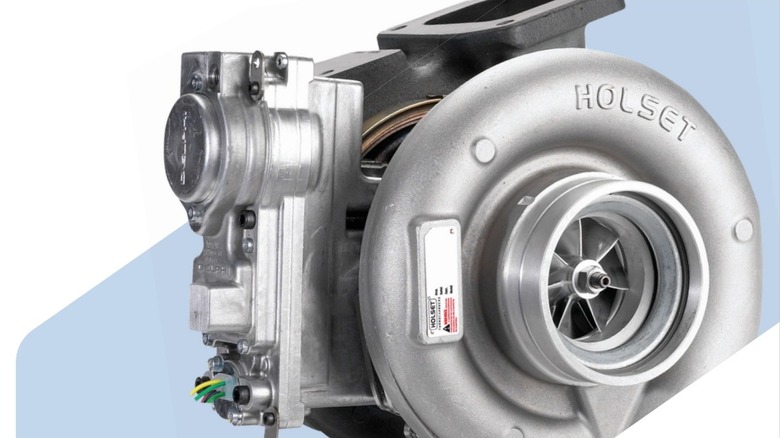What Size Is The Stock Turbo On A 6.7 Cummins?
Turbocharging transforms engine performance and the technology was first used in trucks in the late 1930s. However, it wasn't until the '80s, when emissions regulations were increasingly at the forefront, that turbochargers started becoming more prominent in pickups. In 1989, the first RAM with a Cummins engine under the hood was launched, and it featured a turbocharger which enabled 400-pound feet of torque. Today, you might notice fewer naturally aspirated diesel engines and there are some good reasons why.
Fast forward to 2007, and the mighty 6.7-liter Cummins becomes available and is still the most potent choice for the RAM heavy-duty trucks today. The 6.7-liter Cummins turbo diesel inline-six engine can generate 850-pound feet of torque and pull an impressive 22,660-pounds. Holset, which was acquired several decades ago by Cummins, makes the turbochargers in the RAM engines. The 6.7-liter uses the Holset HE300 series which features a compressor size of 60mm.
A turbocharger consists of a shaft with a compressor and turbine wheel. Turbocharger sizes are often represented as a measurement in millimeters from the very tip of the blade on one side to the tip of the blade on the opposite. You might see a set of numbers such as 60/66, which simply includes the measurement of the compressor blades followed by the turbine blade size, both in millimeters.
Why is it important to use the correct size turbocharger in your engine?
When you want as much power as possible, there are some easy performance upgrades for your diesel truck. But don't make the mistake of trying to install the biggest turbocharger you can find without first ensuring it will work well with the 6.7-liter Cummins.
For example, a turbocharger must build the necessary pressure it needs to spool up, and it requires energy produced from exhaust gasses. If the turbocharger's size is too great, your performance at low RPM will be noticeably disappointing. This is because the engine wouldn't be able to offer up enough exhaust gas to build adequate pressure enabling the turbocharger to work properly. This would have big impact on engines like the 6.7-liter Cummins that are known for their phenomenal torque at low RPM, which helps bolster figures like towing capacity.
A turbocharger that is too small creates the opposite problem. The low-end will perform well, but as you continue to accelerate, the insufficient capacity of a smaller turbo will begin to negatively disrupt vital airflow, making it difficult for the engine to breath properly.
Fortunately, there are ways to check if your engine can handle a turbo, but it's essential to strike a careful balance even with stock components. For example, if you were to take the stock HE351VE turbo available in the 6.7-liter Cummins and pushed it too far with aggressive tuning, you can reach dangerously high exhaust gas temperatures potentially burning out the turbocharger itself.

